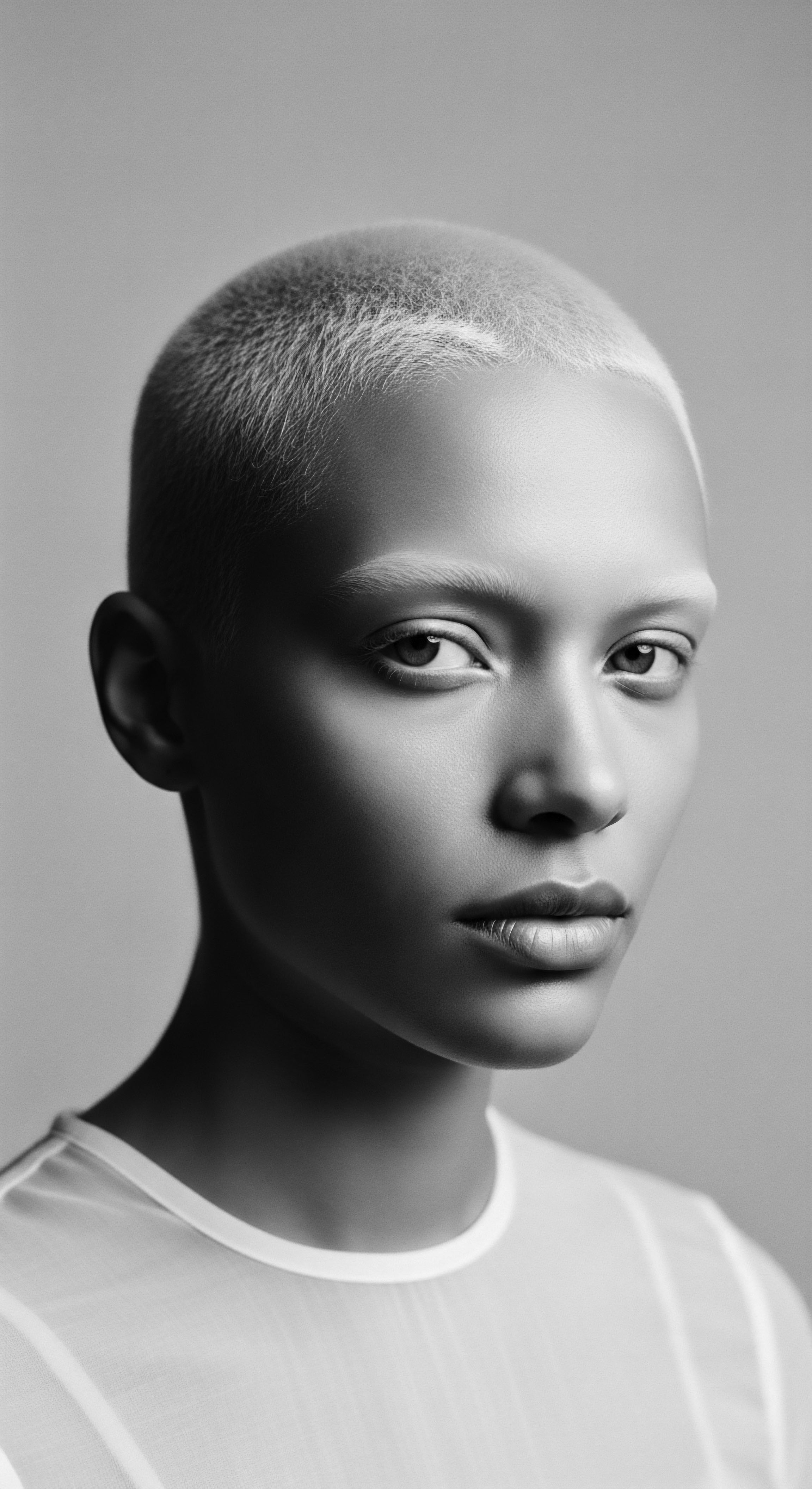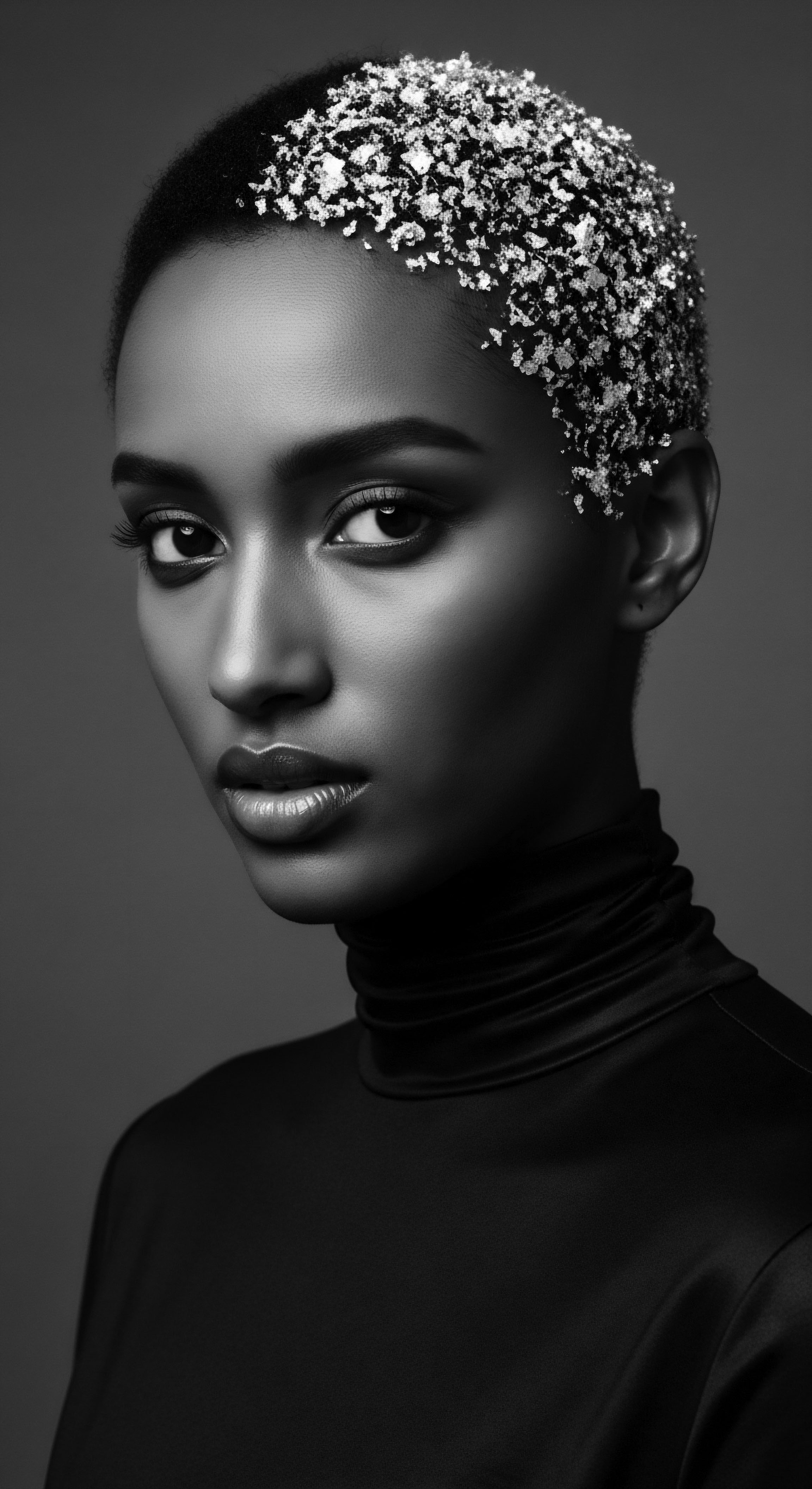
Fundamentals
The term ‘Mixed-Race Heritage’ delineates an individual’s ancestry stemming from two or more distinct racial or ethnic groups. This concept carries profound meaning, extending beyond a mere biological fact, especially within the intricate tapestry of human experience and the profound stories woven into our hair. The expression signifies a lineage where the confluence of diverse heritages shapes one’s identity, physical attributes, and cultural belonging. For many, this heritage represents a rich amalgamation, a living archive of journeys, resilience, and adaptations across generations.
Societally, ‘Mixed-Race Heritage’ has often been viewed through various lenses, evolving from historical categorizations rooted in systems of power to a more contemporary understanding of fluid, self-identified identities. The physical manifestations of this mixed lineage, such as variations in skin tone, facial structures, and perhaps most visibly, hair texture, often become markers that prompt societal classification. These classifications, however, do not always align with an individual’s personal sense of belonging or their deeply felt cultural ties.
The history of mixed-race individuals is a story of fluidity and adaptation, particularly in the ways identity is negotiated. The concept of race itself, a social construct, has historically led to varying categorizations for individuals with mixed ancestry. Early systems often applied notions like “hypodescent,” where a person of mixed racial heritage was assigned to the racial group perceived as inferior, commonly known as the “one-drop rule”.
This historical categorization, while deeply problematic, shaped social standing and access to resources for countless individuals for centuries. Over time, however, a more nuanced understanding of ‘Mixed-Race Heritage’ has begun to emerge, recognizing the intricate layers of self and collective identity it encompasses.

Understanding Mixed-Race Heritage Through Hair
Hair, in particular, serves as a deeply personal and visible indicator of ancestry, carrying a profound cultural significance for those with mixed-race heritage. The varied curl patterns, thicknesses, and textures often observed in mixed-race hair are direct echoes of combined genetic contributions. These characteristics, ranging from straight to wavy, curly to coily, or kinky, tell a story of intermingled populations and the enduring legacy of diverse genetic pathways.
Hair becomes a tangible connection to ancestral roots, reflecting the blend of lineages that define a mixed-race individual. This visible manifestation prompts dialogue about belonging, beauty standards, and the reclamation of self-definition.
Mixed-Race Heritage denotes a personal history born from the intermingling of distinct racial or ethnic lineages, revealing itself often through the rich variations in hair texture and type.
The unique blend of hair characteristics often found in individuals of mixed-race heritage means that conventional hair care approaches, often designed for monoracial hair types, may not be suitable. Understanding the specific needs of these diverse textures requires a departure from generalized practices. This necessitates a journey of discovery, learning to work with the hair’s natural inclinations rather than against them, a practice that mirrors the broader journey of self-acceptance and affirmation of one’s composite heritage.

Intermediate
A deeper exploration of ‘Mixed-Race Heritage’ reveals a concept far more dynamic than a simple genetic mixture; it represents a living dialogue between ancestral lines and contemporary self-perception. This interplay forms a compelling framework for understanding individual and communal identities, especially as societies become increasingly interconnected. The meaning of this heritage is not static, but rather continually re/negotiated through personal experiences, societal interactions, and cultural expressions.
For individuals with mixed-race heritage, their physical appearance, particularly hair texture, can significantly influence how society categorizes them. Research indicates that certain physical traits, often associated with Black ancestry, can lead to mixed-race individuals being perceived as Black, regardless of their other lineages. This societal gaze, often rooted in historical racial hierarchies, creates distinct experiences of belonging and exclusion, shaping one’s connection to various racial and ethnic groups.

The Intertwined Histories of Hair and Identity
The journey of self-identification for those with mixed-race heritage often involves navigating a complex landscape where societal perceptions of hair play a significant role. Historically, in societies with large mixed-race populations, hair became an important tool for social stratification and labeling. The preference for straighter hair, a reflection of Eurocentric beauty ideals, led to a devaluation of curlier or coily textures. This societal pressure to conform prompted many individuals of mixed-race heritage to alter their natural hair textures, a practice that, while offering a semblance of acceptance, often disconnected them from their ancestral hair traditions.
The very act of styling hair became a statement of ethnicity, a means of navigating a racialized social order. Emma Dabiri’s work highlights this profound connection, noting that hair texture and appearance can function as a means of segregation, further emphasizing the deep social implications of hair.
Hair serves as a powerful, visible indicator of mixed-race heritage, shaping societal perceptions and influencing individual identity journeys.
Consider the impact of the Tignon Laws enacted in late 18th-century New Orleans. These laws, issued by Spanish colonial Governor Don Esteban Miró in 1786, mandated that Creole women of color, renowned for their elaborate and enticing hairstyles, cover their hair with a tignon (a scarf or handkerchief). This edict served as a marker of their inferior social status, attempting to diminish their perceived beauty and control their social mobility. Yet, in a remarkable act of resistance and cultural resilience, these women transformed the mandated tignons into vibrant expressions of identity, adorning them with colorful fabrics, jewels, and intricate knots.
This historical example powerfully illuminates how hair, even under oppressive measures, remains a site of profound cultural meaning, resistance, and ancestral practice for individuals with mixed-race heritage, alongside Black communities. Their response demonstrated a deep understanding of adornment as a language of defiance, a way of reclaiming agency in the face of imposed limitations, solidifying hair as a cultural battleground and a canvas for identity.
| Historical Period Ancient African Societies |
| Hair Practice/Significance Intricate braids and styles signifying social status, age, marital status, spiritual beliefs. |
| Connection to Mixed-Race Heritage Foundation of textured hair care, ancestral knowledge for many mixed-race individuals with African roots. |
| Historical Period 18th Century New Orleans (Tignon Laws) |
| Hair Practice/Significance Mandated head coverings (tignons) for Creole women of color. Transformed into elaborate, jeweled headwraps as a form of resistance. |
| Connection to Mixed-Race Heritage Direct illustration of mixed-race women using hair practices to assert identity against oppressive beauty standards. |
| Historical Period 19th-20th Century (Post-Slavery/Colonialism) |
| Hair Practice/Significance Widespread use of chemical relaxers and hot combs to straighten hair, aligning with Eurocentric beauty ideals. |
| Connection to Mixed-Race Heritage Pressure to conform often resulted in altering natural mixed-race hair textures for perceived social and economic advancement. |
| Historical Period Mid-20th Century (Civil Rights/Black Power Movement) |
| Hair Practice/Significance Afro as a symbol of Black pride and resistance against Eurocentric beauty standards. |
| Connection to Mixed-Race Heritage Reclamation of natural textures for mixed-race individuals, a public declaration of racial and cultural pride. |
| Historical Period This table underscores how hair, across different historical moments, has consistently served as a testament to identity, resilience, and the enduring heritage of mixed-race individuals and Black communities. |
Moreover, modern research continues to explore the complexities of hair in shaping identity for Black and mixed-race women. A study involving qualitative interviews with Black and mixed-race women in England and Germany found that participants used hair textures and styles to negotiate and redefine their identities as they moved between different contexts. This dynamic reveals that the very manner in which one styles their hair can be an active performance of self, a negotiation of how they are seen and how they wish to be seen in the world. The significance of hair, therefore, extends beyond mere aesthetics, becoming a powerful tool for expressing one’s cultural identity and personal heritage.

Academic
The academic meaning of ‘Mixed-Race Heritage’ transcends a simplistic demographic classification, evolving into a sophisticated lens through which to comprehend the complexities of human identity, belonging, and the enduring legacies of historical processes. It signifies a socio-cultural and biological phenomenon arising from the intermingling of diverse racial and ethnic ancestries, shaping not only individual phenotype but also intricate patterns of psychosocial development and collective cultural expression. The elucidation of this term requires a rigorous examination of its historical genesis, its fluidity across various geo-cultural contexts, and its profound implications for self-perception, societal integration, and the lived experiences of individuals.
Academically, ‘Mixed-Race Heritage’ is not a fixed, biological category but rather a dynamic construct, subject to prevailing social perceptions and historical ideologies of race. As Omi and Winant (2011) posited, race is a social construction, and societal ideas of what members of each race physically embody are direct results of this construction. For individuals with mixed-race heritage, their physical appearance, such as hair texture, skin color, and facial features, often leads to categorization by society, frequently aligning with the racial group deemed “inferior” through practices like hypodescent.
This highlights the intricate interplay between biological inheritance and social assignment in shaping mixed-race identity. Consequently, ‘Mixed-Race Heritage’ can be seen as a conceptual space where multiple racial scripts intersect, creating unique identity challenges and opportunities.

The Textured Helix ❉ Hair as a Lived Archive of Mixed-Race Heritage
Within the academic discourse, the particular characteristics of textured hair—ranging from wavy to coily—serve as a compelling biological and cultural marker of Mixed-Race Heritage, providing a tangible link to ancestral origins. The very morphology of hair strands, from their follicular shape to their protein structure, reflects a rich genetic legacy that can be traced back through diverse populations. For individuals of African and European descent, for instance, hair often manifests as a complex interplay of genetic contributions, resulting in distinct curl patterns that resist singular classification. This diversity, often perceived as a challenge in Eurocentric beauty paradigms, becomes a potent symbol of resilience and a living testament to interwoven histories.
Consider the significant case study of intergenerational transmission of racial trauma through hair care practices within African American families, as explored in recent scholarly work (De Souza Ramos, 2024). This research, grounded in a phenomenological approach with interviews among African American women, revealed that societal pressures to conform to Eurocentric beauty standards often manifest within familial hair care rituals, perpetuating racial trauma from mothers to daughters. Older generations, having navigated a world that devalued textured hair, frequently internalized these biases, leading them to encourage chemical straightening or other altering practices for younger family members. This dynamic, while born of a desire for protection and acceptance in a hostile society, inadvertently reinforced negative perceptions of natural hair.
A participant in one study recounted her mother’s beliefs about “bad hair,” illustrating this intergenerational transmission of sociocultural attitudes. This narrative of hair care, therefore, becomes a site where the very meaning of one’s mixed-race heritage is both negotiated and, at times, contested within the intimate sphere of the family. The act of caring for mixed hair becomes a complex ritual, balancing inherited wisdom with external pressures, and often, a journey of healing and reclaiming ancestral beauty.
Academic understanding of Mixed-Race Heritage reveals it as a dynamic socio-cultural construct, profoundly shaped by historical power structures and visibly expressed through the textured complexities of hair.
The academic investigation of hair as a component of Mixed-Race Heritage extends to the broader socio-political implications of hair texture. Emma Dabiri, in her scholarly work, elucidates how Black hair has been appropriated and stigmatized throughout history, acting as a site of oppression, resistance, and self-expression. Her analysis transcends personal narrative, engaging with the collective experiences of Black and mixed-race women and their relationship with hair within the context of global racism. This intellectual engagement validates the lived experiences of those with mixed-race heritage, demonstrating how their hair choices are not merely aesthetic preferences but deeply embedded cultural and political acts.
The scrutiny and control exerted over Afro-textured hair, dating back to slavery, persist in contemporary society, with implications for employment and social acceptance. This highlights the ongoing “racialization” of hair, where particular textures become linked to racial distinctions and hierarchies.
- Hair Texture as a Societal Categorizer ❉ Research indicates that hair texture, particularly coily or kinky hair, often leads to mixed-race individuals being perceived and categorized as Black, influencing their social standing and experiences of identity. This external perception can create tension with an individual’s personal self-identification.
- Cultural Heritage in Hair Practices ❉ Traditional African hair practices, such as intricate braiding and styling, were not simply aesthetic choices; they conveyed social status, age, marital status, and spiritual beliefs. These practices represent a significant portion of the ancestral heritage for many mixed-race individuals with African lineage, forming a continuous line of cultural knowledge and care rituals.
- Resistance and Reclamation through Hair ❉ The historical response to oppressive mandates, like the Tignon Laws, where head coverings became elaborate statements of defiance, exemplifies how hair serves as a site of resistance. Modern movements celebrating natural hair continue this legacy, allowing mixed-race individuals to reclaim their authentic textures as an expression of pride and a rejection of Eurocentric beauty standards.
Furthermore, the scholarly pursuit of understanding Mixed-Race Heritage necessitates a consideration of its interdisciplinary nature. Fields such as psychology, sociology, anthropology, and critical race studies all contribute to a holistic comprehension of this identity. For instance, social psychology examines how racial identity is shaped by social interactions and how physical appearance, including hair texture, influences self-perception and how one is perceived by others.
The concept of “racial identity invalidation,” where individuals feel denied inclusivity in a racial group they identify with due to their appearance, is a direct consequence of these societal interactions. This underscores the profound psychological impact of external categorizations on the internal experience of Mixed-Race Heritage.
The political dimensions of hair within Mixed-Race Heritage are also a significant area of academic inquiry. Hair discrimination, particularly against textured hair, continues to be a civil rights issue, with legal battles and legislation like the CROWN Act addressing race-based hair policies in various regions. These efforts highlight the ongoing struggle for equity and the recognition of diverse hair textures as legitimate expressions of identity and heritage, not subjects of scrutiny or discrimination. The continuous re/negotiation of beauty standards and the persistent efforts to decolonize perceptions of hair underscore the vibrant, lived reality of Mixed-Race Heritage.

Reflection on the Heritage of Mixed-Race Heritage
The journey through the definition of Mixed-Race Heritage has been a deeply resonant exploration, revealing not merely a demographic category, but a vibrant and continuous testament to the human spirit’s capacity for adaptation and resilience. Our contemplation of this heritage, particularly through the lens of textured hair, illuminates a profound truth ❉ that within each strand, a story of ancestral wisdom, cultural blending, and persistent self-definition resides. These are the echoes from the source, the living traditions woven into the tender thread of care, and the bold statements that shape the unbound helix of future possibilities.
As we pause to consider the lasting meaning, it becomes clear that Mixed-Race Heritage is a dynamic cultural archive, constantly being written by the lived experiences of individuals. It is a space where the past actively informs the present, where ancestral practices of hair care, borne of necessity and artistry, continue to offer guidance for contemporary wellness. The resilience demonstrated by those who, against historical pressures, found ways to celebrate their unique hair textures—transforming mandates into vibrant expressions of defiance—speaks volumes about the enduring power of cultural identity. This ongoing dialogue between inherited traits and chosen expressions is a beautiful dance, a testament to the soul of a strand and the collective spirit it represents.
The understanding of Mixed-Race Heritage is not confined to academic texts or historical records; it breathes within every intentional act of hair care, every shared story of identity, and every celebration of diverse textures. It is a heritage that invites us to look beyond rigid classifications, instead recognizing the flowing currents of human connection and the strength found in multiplicity. This is a journey of appreciation, honoring the diverse lineages that converge in a single individual, allowing each person to stand fully in the beauty of their unique inheritance, connected to a vast, interwoven past.

References
- Campion, M. (2019). The Mixed-Race Experience ❉ A Sociological Analysis of Black and White Identity. Routledge.
- De Souza Ramos, G. (2024). Detangling Knots of Trauma ❉ Intergenerational Transmission of Racial Trauma Through Hair Care Processes Between Mothers and Daughters In African American Families. University Digital Conservancy.
- Dabiri, E. (2020). Twisted ❉ The Tangled History of Black Hair Culture. Harper Perennial.
- González Echevarría, R. (2013). The Culture of Curls ❉ What Hair Really Means in Mixed Race Societies. The Yale Globalist.
- Khanna, N. (2011). Passing for Who? Identity and Ideology in the Lives of Multiracial People. Temple University Press.
- Leverette, A. (2009). The Challenges of Being Biracial in America ❉ A Critical Race and Qualitative Study. ProQuest LLC.
- Lukate, J. M. & Foster, J. L. (2023). ‘Depending on where I am…’ Hair, travelling and the performance of identity among Black and mixed-race women. British Journal of Social Psychology, 62(1), 342-358.
- Miró, E. (1786). Edict of Good Government (Tignon Laws).
- Omi, M. & Winant, H. (2011). Racial Formation in the United States. Routledge.
- Patton, T. O. (2006). “Hey Girl, Am I More than My Hair?” ❉ African American Women and Their Struggles with Beauty, Body Image, and Hair. NWSA Journal, 18(2).
- Robinson, C. (2018). Black and Mixed-Race Women in the Netherlands ❉ Negotiating Identity. Amsterdam University Press.
- Sims, A. (2016). Race, Hair, and Identity ❉ Examining the Experiences of Biracial Women. Journal of Black Studies.
